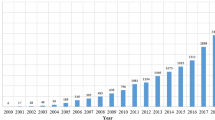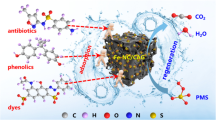Abstract
Among the adsorbents, carbon nanotubes (CNTs) are relatively new nanomaterials which are frequently used for water purification. In this work, experiments were carried out to study the feasibility of regeneration of humic acid-exhausted CNTs using electro-Fenton process. The results showed that electro-Fenton process has high efficiency at pH equal to 3. The results also clearly indicated that the regeneration efficiency at lower molarities of H2O2 such as 0.05 is higher than at higher molarities. The results also implied that the regeneration efficiency at current density equal to 0.1 mA was 98.32 % and with increasing current density, the regeneration efficiency decreased. The regeneration efficiency at molar ratios of Fe2+:H2O2 as 0.03:10 was higher than other examined molar ratios and after five cycles of regeneration decreased to 87%. The results of the present study indicated that electro-Fenton process has high efficiency for the regeneration of CNTs exhausted with humic acid.
Similar content being viewed by others
References
Peng X., Li Y., Luan Z., Di Z., Wang H., Tian B., Jia Z.: Adsorption of 1,2-dichlorobenzene from water to carbon nanotubes. Chem. Phys. Lett. 376, 154–158 (2003)
Naghizadeh A., Nasseri S., Nazmara S.: Removal of thrichloroetylene from water by adsorption on to multi wall carbon nanotubes. Iran J. Environ. Health Sci. Eng. 8, 317–324 (2011)
Naghizadeh A.: Comparison between activated carbon and multiwall carbon nanotubes in the removal of cadmium (II) and chromium (VI) from water solutions. J. Water Supply Res. Technol. AQUA 64, 64–73 (2015)
Naghizadeh A., Nasseri S., Rashidi A.M., Rezaei R., Nabizadeh R., Mahvi A.H.: Adsorption kinetics and thermodynamics of hydrophobic natural organic matters (NOMs) removal from aqueous solution by multi-wall carbon nanotubes. Water Sci. Technol. Water Supply 13, 273–285 (2013)
Helland A., Wick P., Koehler A., Schmid K., Som C.: Reviewing the environmental and human health knowledge base of carbon nanotubes. Environ. Health Perspect. 115, 1125–1131 (2007)
Nowack B., Bucheli T.D.: Occurrence, behavior and effects of nanoparticles in the environment. Environ. Pollut. 150, 5–22 (2007)
Yang K., Xing B.: Desorption of polycyclic aromatic hydrocarbons from carbon nanomaterials in water. Environ. Pollut. 145, 529–537 (2007)
Chiang P.C., Chang E.E., Wu J.S.: Comparison of chemical and thermal regeneration of aromatic com- pounds on exhausted activated carbon. Water Sci. Technol. 35, 279–285 (1997)
Tanthapanichakoon W., Ariyadejwanich P., Japthong P., Nakagawa K., Mukai S.R., Tamon H.: Adsorption desorption characteristics of phenol and reactive dyes from aqueous solution on mesoporous activated carbon prepared from waste tires. Water Res. 39, 1347–1353 (2005)
Nakano Y., Hua L.Q., Nishijima W.: Biodegradation of trichloroethylene (TCE) adsorbed on granular activated carbon (GAC). Water Res. 34, 4139–4142 (2000)
Salvador F., Jiménez C.S.: A new method for regenerating activated carbon by thermal desorption with liquid water under subcritical conditions. Carbon 34, 511–516 (1996)
Rege S.U., Yang R.T.: Desorption by ultrasound: Phenol on activated carbon and polymeric resin. AIChE J. 44, 1519–1528 (1998)
Derakhshani E., Naghizadeh A.: Ultrasound regeneration of multi wall carbon nanotubes saturated by humic acid. Desalin. Water Treat. 52, 7468–7472 (2014)
Naghizadeh, A.; Nasseri, S.; Mahvi, A.H.; Rashidi, A.; Nabizadeh, R.; Rezaei Kalantary, R.: Fenton regeneration of humic acid-spent carbon nanotubes. Desalin. Water Treat. (2015). doi:10.1080/19443994.2014.900649
Virkutyte J., Jegatheesan V.: Electro-Fenton, hydrogenotrophic and Fe2+ ions mediated TOC and nitrate removal from aquaculture system: different experimental strategies. Bioresource Technol. 100, 2189–2197 (2009)
Duesterberg C., Cooper W., Waite T.: Fenton-mediated oxidation in the presence and absence of oxygen. Environ. Sci. Technol. 39, 5052–5058 (2005)
Shen L., Yan P., Guo X., Wei H., Zheng X.: Three-dimensional electro-Fenton degradation of methyleneblue based on the composite particle electrodes of carbon nanotubes and nano-Fe3O4. Arab. J. Sci. Eng. 39, 6659–6664 (2014)
Erick B., Yung-Tse H., Ruth Yu-Li Y., Suleiman M.: Electro coagulation in wastewater treatment. Water Res. 3, 495–525 (2011)
Andreozzi R., Caprio V., Insola A., Marotta R.: Advanced oxidation processes (AOP) for water purification and recovery. Catal. Today 53, 51–59 (1999)
Oturan M., Brillas E.: Electrochemical advanced oxidation processes (EAOPs) for environmental applications. Port. Electrochim. Acta. 25, 1–18 (2007)
Sires I., Garrido J., Rodriguez R., Brillas E., Oturan N., Oturan M.: Behavior of the Fe3+/Fe2+ system in the electro-Fenton degradation of the antimicrobial chlorophene. Appl. Catal. B Environ. 72, 382–394 (2007)
Oturan M.: An ecologically effective water treatment technique using electrochemically generated hydroxyl radicals for in situ destruction of organic pollutants: Application to herbicide 2, 4-D. J. Appl. Electrochem. 30, 475–482 (2000)
Brillas E., Garrido J., Rodríguez R., Arias C., Cabot P., Centellas F.: Wastewaters by electrochemical advanced oxidation processes using a BDD anode and electrogenerated H2O2 with Fe (II) and UVA light as catalysts. Port. Electrochim. Acta 26, 15–46 (2008)
Huling S., Arnold R., Jones P., Sierka R.: Predicting Fenton-driven degradation using contaminant analog. J. Environ. Eng. 126, 348–353 (2000)
Teel A., Watts R.: Degradation of carbon tetrachloride by modified Fenton’s reagent. J. Haz. Mat. 94, 179–189 (2002)
Berenguer R., Marco-Lozar J.P., Quijada C., Cazorla-Amorós D., Morallón E.: Comparison among chemical, thermal, and electrochemical regeneration of phenol-saturated activated carbon. Energy Fuels 24, 3366–3372 (2010)
Methatham, T.; Lu, M.C.; Ratanatamskul, C.: Kinetics of electro-Fenton ferrous regeneration (EFFR) on chlorinated organic compound degradation. Desalin. Water Treat. (2014). doi:10.1080/19443994.2014.886298
Pignatello J.J., Olivers E., Mackey A.: Advanced oxidation processes for organic contaminant destruction based on the fenton reaction and related chemistry. Crit. Rev. Env. Sci. Technol. 36, 1–84 (2006)
Atmaca E.: Treatment of landfill leachate by using electro-Fenton method. J. Hazard. Mater. 163, 109–114 (2009)
Hyung H., Kim J.: Natural organic matter (NOM) adsorption to multiwalled carbon nanotubes: effect of NOM characteristics and water quality parameters. J. Environ. Sci. Technol. 42, 4416–4421 (2008)
Vermeer A., Van Riemsdijk W., Koopal L.: Adsorption of humic acid to mineral particles, specific and electrostatic interactions. J. Langmuir 28, 9–14 (1998)
Ritchie J., Perdue E.: Proton-binding study of standard and reference fulvic acids, humic acids, and natural organic matter. J. Geochim. Cosmochim. Acta 67, 85–96 (2003)
Bañuelos J.A., Rodríguez F.J., Rocha J.M., Bustos E., Rodríguez A., Cruz J.C., Arriaga L.G., Godínez L.A.: Novel electro-Fenton approach for regeneration of activated carbon. Environ. Sci. Technol. 47, 7927–7933 (2013)
Zongo I., Leclerc J., Maïga H., Wéthé J., Lapicque F.: Removal of hexavalent chromium from industrial wastewater by electrocoagulation: a comprehensive comparison of aluminium and iron electrodes. Sep. Purif. 26, 8–15 (2013)
Huling S., Kan E., Wingo C.: Fenton-driven regeneration of MTBE-spent granular activated carbon—effects of particle size and iron amendment procedures. J. Appl. Catal. B Environ. 6510, 7–89 (2009)
Author information
Authors and Affiliations
Corresponding author
Rights and permissions
About this article
Cite this article
Naghizadeh, A. Regeneration of Carbon Nanotubes Exhausted with Humic Acid Using Electro-Fenton Technology. Arab J Sci Eng 41, 155–161 (2016). https://doi.org/10.1007/s13369-015-1643-8
Received:
Accepted:
Published:
Issue Date:
DOI: https://doi.org/10.1007/s13369-015-1643-8




